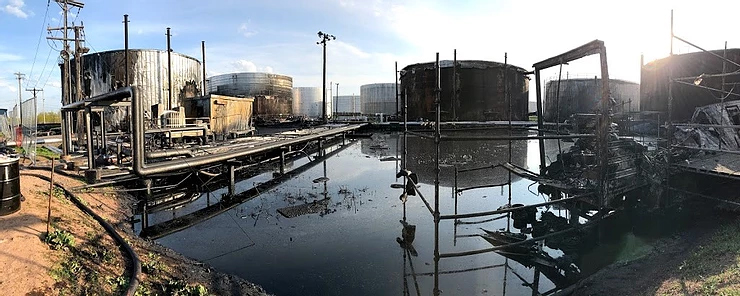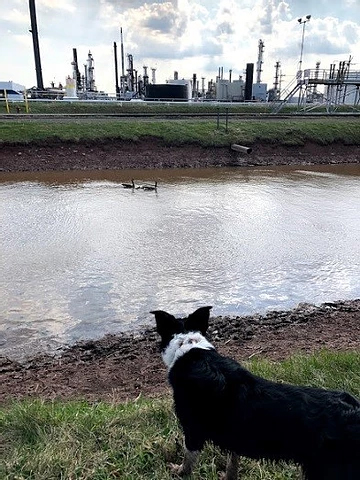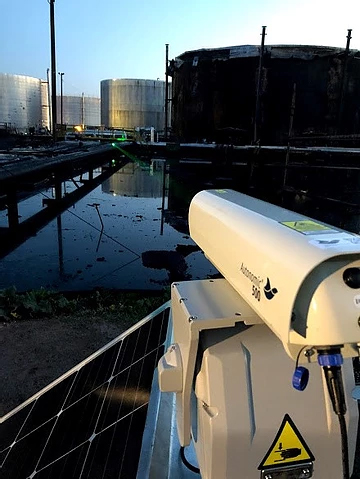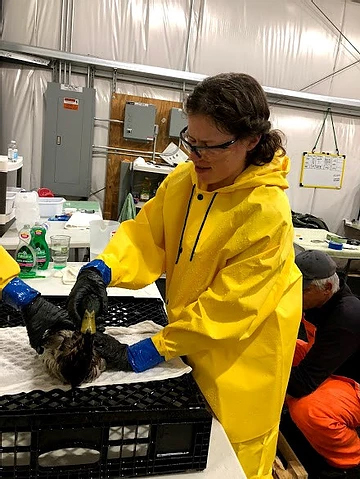Emergency Response to Wildlife Challenges in Oil Refinery
Nov 8, 2018
On a cold morning in late April an explosion tore through a midwestern oil refinery resulting in a large fire and the release of thousands of barrels of petroleum products from a ruptured storage tank. Fortunately, there were few serious injuries and no human casualties associated with the incident and the focus quickly turned from fire and rescue to clean up and environmental management. Within a few days of the initial incident, CDIS Environmental K9 Group was contacted to determine how we could contribute to the protection and management of wildlife within the area in conjunction with the rehabilitation response contractor. Our unique combination of resources, training, and experience enabled us to rapidly deploy a team of avian wildlife experts, 4 specially trained wildlife canines, and the associated equipment needed for a full-scale avian wildlife deterrent response including boats, lasers, and an all-terrain utility vehicle.
Our initial response efforts were targeted towards reducing the overall population of waterfowl utilizing the refinery property in general especially around the firewater and stormwater ponds and the tank farm area. By discouraging the existing resident waterfowl population we were able to reduce the number of birds at risk of being exposed to oil contamination.
A combination of canine patrols, kayaks, remote controlled boats, and handheld lasers were strategically deployed throughout the day and night to immediately reduce the presence of waterfowl in the area. Additionally, nest and egg removal activities were conducted whenever possible in accordance with humane standards and under state and federal permit processes. Throughout the active hazing process, CDIS-EKG wildlife experts were continually monitoring the site for at risk and oiled wildlife. Our deterrent efforts resulted in a reduction of the daily waterfowl population from over 100 individuals routinely present on site, to 6 flightless family groups present in clean water areas.


While the response team maintained an active canine and deterrent patrol throughout the site to prevent Canada goose molt migrant groups from moving in, we were also able to dedicate time towards evaluating the site in order to safely incorporate a program to deter waterfowl from entering warm and hot zone areas. These areas had standing oil pools from the release that could easily attract waterfowl resulting in additional oiled birds needing treatment and rehabilitation. A combination of exclusion fencing, flagging and visual deterrents were installed through combined efforts of the CDIS-EKG team and the Focus Wildlife rehabilitation contractor.
Additionally, CDIS-EKG incorporated a comprehensive automatic laser deterrent program throughout the heavily impacted areas. The program consisted of 8 solar powered Agrilaser Autonomic lasers specifically programmed by EKG wildlife experts to deter waterfowl from landing in oil impacted areas for night roosting. All of the tools and techniques utilized in the warm and/or hot zones within the refinery had to be designed and deployed in a manner that accounted for the ever-changing conditions of an incident response environment, in accordance with strict safety standards, and in a manner that would not interfere with clean-up and emergency response activities.
Although all practical measures to protect wildlife were initiated as soon as safely possible, there were a number of birds that were exposed to oil during the early stages of the incident, as well as a few individuals that became exposed during the changing conditions of the clean-up operations. EKG biologists assisted Focus Wildlife licensed rehabilitators with monitoring, capturing, washing and care for exposed wildlife. Capture techniques included netting, trapping, and corralling individuals based on the needs and condition of each animal. Birds were cared for, cleaned and properly conditioned back to health before being released at off-site nature areas designated by the state wildlife agency.

Animal Behaviorist, Vanessa Williams, assists in cleaning waterfowl covered in oil.
After 2 months of intensive wildlife deterrent, capture, care, and monitoring activities, all oiled wildlife were accounted for and released. Canada goose molt season was in full effect and no geese remained on the property. At that point the EKG wildlife consulting team began designing a long-term wildlife management plan to limit wildlife presence around the refinery to minimize future wildlife exposure to danger and reduce damage and maintenance needs caused to the refinery equipment by wildlife.
CDIS Environmental K9 Group operated for over 600 hours during this emergency response without any safety infractions, incidents, or near-misses. Throughout the project period conditions were continuously evolving. Written protocols and constant communication between EKG teams and other response agencies were critical to the success of the wildlife deterrent program throughout the oil and gas product release incident. The CDIS-EKG team was able to successfully deploy a full-scale response effort to reduce the risk of oil exposure to native wildlife in the area, maintain strict safety protocols throughout the project, and plan for long term sustainable wildlife management for the property.


 0
0
